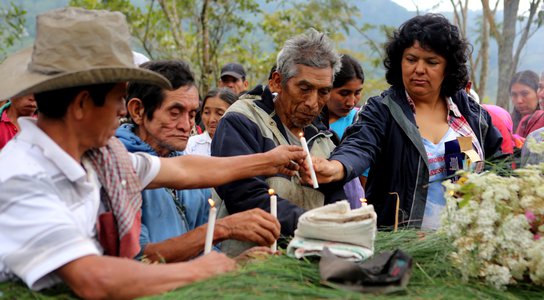Two of this year’s Goldman Environmental Prize[i] winners embody the severe risks facing environmental activists in Peru and Cambodia, which rank among the world’s most dangerous countries to defend the natural world according to Global Witness data.
This year’s winner from South America, Máxima Acuña de Chaupe, has been beaten by police and suffered years of intimidation for refusing to allow the construction of an open-pit gold mine on her land. Asia’s winner, Ouch Leng, is regularly followed and threatened by forest authorities and logging companies for his investigative work into the country’s multi-million dollar black market in illegal wood, which is gutting the country’s last forests.

The acute vulnerability of people who take a stand against destructive industries was recently demonstrated with the murder of one of the 2015 Goldman prize winners. Berta Cáceres had received years of death threats because of her opposition to a hydro-electric dam on her community’s land in Honduras. She was supposed to be under Honduran police protection, but was tragically shot dead in her home last month.
Global Witness is calling on governments to protect environmental defenders like Berta, Máxima and Leng, who are coming under increasing attack.
“The Goldman Environmental Prize is an important recognition of the heroic work of the thousands of people worldwide who take a stand against environmental destruction. Berta Cáceres’ murder was a shocking reminder of the increasing vulnerability of the activists in these modern-day David and Goliath stories,” said Billy Kyte, campaigner at Global Witness. “Two of this year’s winners, Máxima and Leng, have courageously faced up to powerful state and corporate forces in Peru and Cambodia - two of the world’s most dangerous countries for environmental activism.”
Global Witness’ 2015 report How Many More? shows that between 2002 and 2014 at least 57 defenders were murdered in Peru, making it the fifth most dangerous country for environmental activism. Cambodia ranked ninth with 14 deaths. New data suggests that last year 12 more were killed in Peru and 2 more in Cambodia.
Máxima Acuña de Chaupe is an indigenous Peruvian farmworker who has survived violent eviction attempts for her resistance to the construction of a $4.8 billion gold mine on her land.[ii] Five demonstrators were killed by police in protests against the World Bank-funded Conga mine in 2012.
At least 61 activists have been killed in Peru over the last ten years, with almost 80% of deaths related to mining. Peru recently weakened its environmental laws in order to boost mining investment.[iii] It also made it easier for the police and army to get away with killings by reducing their criminal responsibility if they cause injury or death on duty.[iv]
Despite years of threats and intimidation Ouch Leng has persisted in his investigations into how Cambodia’s ruling elite is profiting from Cambodia’s trade in illegal timber, which is robbing forest-dependent communities of their land and livelihoods. At least five deaths have been linked to logging in Cambodia since 2007, including the deaths of two forest rangers in 2015 by suspected illegal loggers.[v] Last month a young forest activist was hacked by a machete whilst investigating rampant illegal logging in Cambodia’s Prey Lang forest. [vi]
Worldwide at least 30 forest defenders were murdered between 2012 and 2014 alone. Over the same period 77 were killed for defending their land against mining.
“As pressure on land and natural resources intensifies, ordinary people are increasingly finding themselves in the firing line of powerful vested interests. At best governments are turning a blind eye to killings, at worst they are complicit in their deaths,” said Kyte. “Urgent action is needed to protect those under threat, investigate crimes, and bring perpetrators to justice. But governments must also tackle the root causes of violence, which dictate that “development” comes at the expense of the natural world and the people who seek to defend it.”
/ENDS
For interviews and other information please contact:
Billy Kyte, Senior Campaigner (London) +44(0)7891 3603590 [email protected]
Alice Harrison, Communications (London) +44(0) 7841 338792 [email protected]
[i] The Goldman Environmental Prize is a prestigious award recognising grassroots environmentalism around the world. It is awarded annually to one activist across six continents.
[ii] See International Consortium of Investigative Journalists (ICIJ) and Huffington Post (15 April 2015), Gold Rush: How The World Bank Is Financing Environmental Destruction. Available at: http://projects.huffingtonpost.com/worldbank-evicted-abandoned/how-worldbank-finances-environmental-destruction-peru
[iii] With the passing of law 30230 the Ministry of Environment’s authority to designate protected lands exempt from industrial activity has been revoked. Further, the law reduces the time designated for the evaluation of Environmental Impact Assessments of extractive projects. Law 30230 available at: http://www.minem.gob.pe/minem/archivos/file/Mineria/LEGISLACION/2014/JULIO/LEY30230.pdF
[iv] Law 30151 available at: http://www.leyes.congreso.gob.pe/Documentos/Leyes/30151.pdf
[v] See National Geographic (3 Feb 2016), Illegal Logging Has Become More Violent Than Ever. Available at: http://news.nationalgeographic.com/2016/02/160202-Illegal-loggers-murders-violence-defending-land/
[vi] See Global Witness Press Release (29 March 2016): https://www.globalwitness.org/en/press-releases/machete-attack-award-winning-cambodian-activist-part-global-trend-violence-against-forest-defenders/
/ ENDS
You might also like
-
Report How Many More?
New report shows killings of environmental activists are increasing, with indigenous communities hardest hit.
-
Press release We express shock and outrage at murder of Berta Cáceres in an open letter to the Honduran President

-
Report Peru's Deadly Environment
As Peru prepared to host the 2014 UN climate talks, four murders in its Amazon were tragic reminders of a paradox at work in Peru’s forest sector.